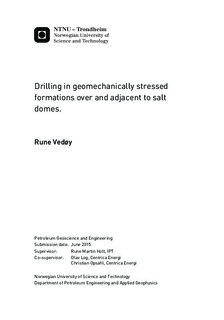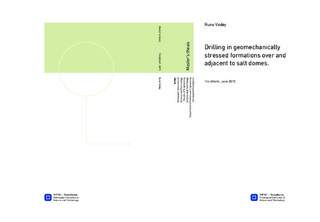| dc.description.abstract | This thesis is in two parts:
The first part is a literature study with the intent of identifying the general behavior of stress perturbations related to some standard, often seen, salt geometries. The second part is an investigation of wellbore stability surrounding the Butch salt diapir in the South-west North Sea. From the calculations done for several different well trajectories, the effect of the salts stress perturbations gives insight into where it is best to drill, and how. These two parts where connected to give a set of guidelines for drilling close to salt diapirs such as the Butch salt diapir.
Salt structures can cause strong stress perturbations, compared to the far field, in the adjacent formations. The salts inability to sustain deviatoric stresses are the cause of these perturbations. How the stresses are distributed will be a strong factor of the geometry of the salt body. Flat allochthonous salt will have reduced minimum principal stresses above and below. Convex curves will show a decrease in minimum principal stress and therefore an increase in shear stresses, whilst concave curves will have an increased minimum principal stresses and lower shear forces due to horizontal loading from the salt. Connected salt diapirs will generally have a decrease of the minimum principal stress, hoop stress, an increase of the radial stress, maximum horizontal, whilst the vertical stress will vary depending on the density of the salt compared to the sediments surrounding it. The stress perturbations surrounding a salt body will in all likelihood lead to a re-orientation of the stress directions surrounding it. The disturbances in the stress field can extend up to 1 times the width of the salt, with the severity reducing further away from the salt. When planning to drill a well in an area with a salt body, a certain distance should be kept from the salt, especially in the upper part of a salt diapir with a high slope. If drilling is desired in the upper parts of a salt diapir, the best direction to drill would be directly towards it. The worst would be drilling parallel close to the salt. At the base of a diapir, it is expected that the stress perturbations are smaller than for the upper part, having less constrains on the well trajectory. Proper stress and material properties estimations are important close to the salt. A 3D geomechanical model is a good way of achieving relatively good stress estimations. | |

